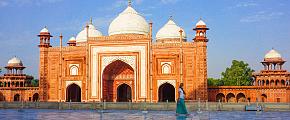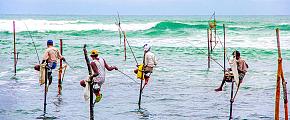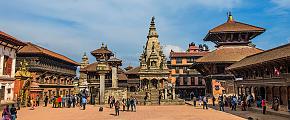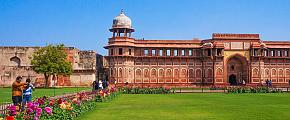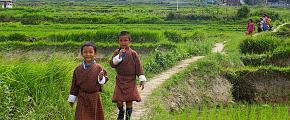10 Religious Sites to Visit in Bhutan
Bhutan is a land adorned with thousands of religious sites that provide education and spiritual enlightenment to the Bhutanese people. From the iconic Tiger's Nest perched on a cliffside to the serene Punakha Dzong, each religious site tells the story of history and holds its own charm. In this article, let's take a closer look at these places which includes five dzongs and five lhakhangs of great importance in terms of historical significance and worthiness for a visit.
The difference between Dzongs, Lhakhangs & Temples
In Bhutan, the governance system is combined religion with politics. The government officials and high-ranking lamas work in the same building, each responsible for maintaining social order and spiritual beliefs. These shared office spaces are known as "dzongs", serving as fortresses in the locality. In addition to dzongs, temples are dedicated solely to worshipping Buddhist idols, known as "lhakhangs". While dzongs and lhakhangs differ in architectural style, functionality, and historical roles, they both serve as places for religious activities, attracting visitors from around the world.
- Dzongs: The building with both administrative and religious facilities, usually closed to the public during working hours.
- Lhakhangs: The temple in the Himalayas, which means the house of the gods, is the building with only religious function, also the places where cultural activities and festivals are celebrated.
- Temples: The building used for religious worship.
Paro Dzong
Also referred to as Rinpung Dzong or the "Fortress of the Heaps of Jewels," it is located on the banks of Bhutan's Paro Valley. The ancient fort is a defensive structure constructed in the 17th century and sits close to the town of Paro.
Paro Dzong topped most of the visitors' favorites. Partly because some of the scenes can be viewed from the 1993 English-language film Little Buddha, which was filmed in this dzong, but more importantly, the unique architectural features and beautiful backdrop capture the essence of Bhutanese cultural heritage which represents their artistry harmonious coexistent with the environment. You can find that the large beams in the temple are cleverly interlocked without the use of nails which displayed remarkable craftsmanship. With the Paro Valley surrounded by majestic mountains and lush green landscapes, this natural beauty further enhances the overall charm of the dzong, creating a memorable experience. Inside the dzong, you can explore galleries showcasing ancient thangka paintings and religious artifacts.
Moreover, this dzong hosts an extraordinary annual festival called Paro Tshechu which is the most important festival to commemorate the birth of Guru Rinpoche, one of the founding figures of Tibetan Buddhism. This festival spans from the eleventh to the fifteenth day of the second month in the traditional Bhutanese lunar calendar. During this special occasion, thousands of people donning their finest attire, gather in the dzong for praying, burning of incense, and participating in religious ceremonies to express their devotion and reverence.
 Paro Dzong
Paro Dzong
Punakha Dzong
Built in the 17th century, Punakha Dzong sits at the Pho Chhu and the Mo Chhu rivers' meeting points, symbolizing masculine and feminine energies. It is about a two to three-hour drive from the capital, Thimphu. This remarkable dzong is the second oldest and second largest in Bhutan, also known as the Palace of Great Bliss.
Punakha Dzong houses a vast collection of Bhutanese Buddhist manuscripts, sacred registers of Buddhist figures, religious paintings, and lifelike portraits of revered individuals. The central courtyard preserves the remains of Shabdrung Ngawang Namgyal, the founder of Bhutan.
Furthermore, if you travel to Bhutan in May, you'll be captivated by the breathtaking jacaranda blooms in the fortress courtyard as the vibrant bluish-purple flowers cascade from the trees, creating a mesmerizing view. The delicate fragrance of the flowers fills the air and adds to the allure of Punakha Dzong's beauty.
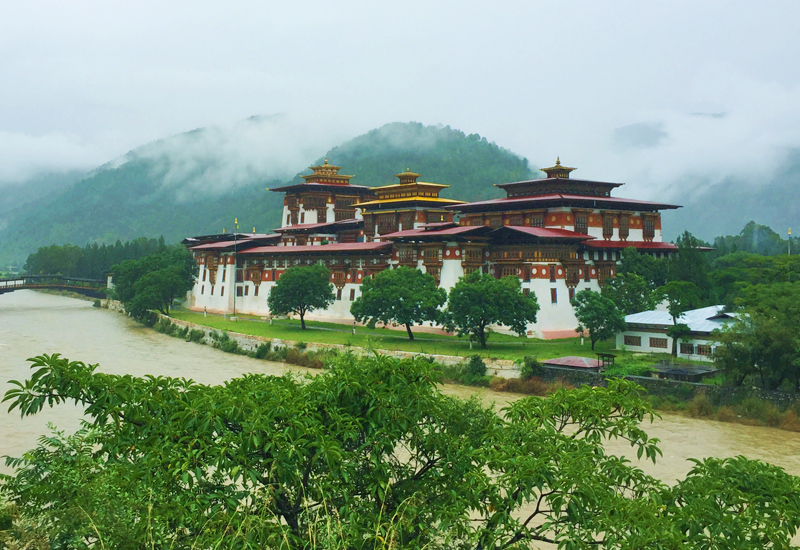 Punakha Dzong
Punakha Dzong
Tashichho Dzong
Originally constructed in the 13th century, Tashichho Dzong proudly stands on the western bank of the Wang Chhu River at an elevation of 2500 meters. Located in Thimphu, the capital of Bhutan, it is a well-known Buddhist monastery and an important governmental center.
Currently, Tashichho Dzong serves as the summer residence for religious leaders and central religious institutions, as well as housing the throne room offices of the king, secretariat, and the ministries of internal affairs and finance. The white lime-washed exterior walls and golden-roofed towers give the dzong an aura of grandeur.
While you are not permitted to visit the Royal and government offices, you can still explore the dzong and appreciate its magnificent architecture and surrounding area. One of the notable features is its beautifully landscaped gardens, which provide a peaceful ambiance for visitors. It showcases a variety of native plants and flowers, creating a tranquil environment to the dzong. When visiting between April and July, you will be greeted by a vibrant display of colorful rhododendron flowers along the pathway. Alternatively, a visit in March may offer the opportunity to witness the blooming cherry trees, if luck is on your side.
Trongsa Dzong
Trongsa Dzong was built in the 17th century and strategically locates on a ridge overlooking the Mangde Chhu River. This dzong is a massive and sturdy stone structure, featuring thick walls and fortifications, standing atop a mountain at an elevation of 2200 meters, serving as a military fortress and trade routes between the East and West. Withstanding the test of time for several centuries, its construction remains resilient and steadfast, as a guardian of the Bhutanese people.
This dzong is believed that for the ancestral home of the Bhutanese royal family. Each prince who is about to ascend to the throne before their coronation needs to reside here. It's said that the princes often enjoy watching the passing crowd through the small windows above the dzong, contemplating future governance strategies. Today, it remains a vital cultural and administrative center, where government officials and monks coexist harmoniously, blending ancient traditions with new ideas for the future.
 Trongsa Dzong
Trongsa Dzong
Jakar Dzong
Jakar Dzong, also known as the Fortress of White Bird, is located on a ridge overlooking Jakar town in the beautiful Chamkhar valley of Bumthang. The name "Jakar" translates to "white bird" in the local language. According to legend, a white bird flew and perched on the ridge where the dzong stands today, which was interpreted as a positive omen by a lama. Traditionally, the Dzong played an important role as the fortress of defense of the eastern districts. It was also the seat of the first king, shaping the early days of Bhutan.
Beyond its defensive significance, the majestic environment of Jakar Dzong creates a captivating atmosphere for visitors. As you approach the dzong, the sight of its towering walls and intricate architectural details against the backdrop of the scenic Chamkhar valley is truly awe-inspiring. Therefore, for those who appreciate natural beauty and seek a moment of serenity, Jakar Dzong definitely offers a sanctuary. Its location and the ethereal atmosphere it exudes make it a truly exceptional destination that leaves you with a lasting impression and a deep appreciation for Bhutan's cultural and natural heritage.
Taktshang Lhakhang (Tiger's Nest)
Also known as Tiger's Nest Monastery, Taktshang Lhakhang is perched 900 meters on the end of a cliff overlooking the beautiful Paro Valley and is the most famous temple in Bhutan.
Legend has it that Guru Rinpoche, the great Buddhist master, flew on the back of a tigress to this spot to meditate and subdue a local demon. The temple was subsequently built around the cave where he meditated, and it has since become an important pilgrimage site.
Visiting the Taktshang Lhakhang offers a unique experience and requires a moderate level of physical fitness and hiking ability, as the trail can be challenging. It takes approximately three hours of hiking but rewards you with breathtaking views of the Paro Valley. Surrounded by lush forests and the sounds of nature, you cannot help but feel a sense of peace and tranquility, and the hike becomes more interesting. Upon arrival, one is greeted by the sight of the intricately designed temple, adorned with colorful prayer flags and prayer wheels. The complex consists of several temples and meditation caves, adorned with sacred relics, statues, and murals depicting Buddhist deities and legends. Inside the temple, each floor boasts a balcony that offers panoramic views of Paro Valley, leaving an indelible impression on visitors. The breathtaking vista stretches across the valley, showcasing the verdant fields, meandering river, and distant snow-capped peaks. It's a picturesque tapestry that seems straight out of a dream.
 Tiger's Nest
Tiger's Nest
Kyichu Lhakhang
Kyichu Lhakhang is one of the oldest and most sacred temples in the country. Kyichu Lhakhang is situated in the Paro Valley and is believed to have been built on the left foot of a giant ogress to subdue her. The temple is adorned with colorful prayer flags and surrounded by lush greenery, creating a serene and spiritual atmosphere.
Inside the temple, you can witness intricate wall paintings depicting Buddhist legends and ancient statues. One of the main statues is an eight-year-old equivalent figure of Buddha which is believed a revered symbol in Bhutanese Buddhism. Depicting the youthful form of Buddha, this statue showcases his wisdom and compassion. Adorned in intricate robes and with hands folded in prayer, it radiates a serene and sacred presence, inviting devotees and visitors to seek blessings and spiritual guidance.
Chimmi Lhakhang
Chimi Lhakhang, located in Bhutan's Punakha district, is renowned as the "Fertility Temple". It has a fascinating legend associated with it, believed to bestow blessings of fertility and marital happiness. It's said that the temple was founded by the Buddhist saint Drukpa Kunley, who subdued a demoness and transformed her into a protective deity. Pilgrims visit the temple seeking blessings for conceiving children, and it has become a popular destination for couples from Bhutan and beyond.
Although not particularly large, Chimi Lhakhang encompasses a charming courtyard and a small temple. The central statue depicts Shakyamuni, while on the right stands a small statue of Drukpa Kunley with exaggerated and distorted genitals. Inside the temple, monks tap the heads of worshippers with bone and wooden sculptures representing Drukpa Kunley's genitals, seen as a blessing. Photography is prohibited within the main hall, yet the picturesque countryside surrounding Chimi Lhakhang offers an ideal landscape for capturing memorable shots.
Gangtey Monastery
It is a gorgeous temple that is perched on a hilltop and provides breathtaking views of Phobjikha Valley. Founded in 1963 by Pema Lingpa, a renowned Bhutanese treasure revealer, the temple boasts traditional Bhutanese craftsmanship with intricate woodwork and vibrant Buddhist murals. The central temple, supported by eight pillars, showcases the Tibetan architectural style, while colorful murals on the outer walls depict Tibetan Buddhist iconography. These centuries-old murals still exude charm. Auspicious creatures adorn the temple's roof, and the wooden artifacts used have a 300-year history.
Gangtey Monastery attracts not only locals but also the black-necked cranes that make the Phobjikha Valley their winter home during their migration. On their arrival and before departure, these birds circled the temple three times in a clockwise direction. A one-day occasion called "Black Necked Crane Festival" holds in this temple and celebrates their arrival, featuring sacred dances, including the Crane Dance by local school children, promoting nature conservation in Bhutan.
Tango Monastery
Tango Monastery, located in the Thimphu district of Bhutan, is a renowned Buddhist monastery and one of the country's most important religious institutions. It is a spiritual retreat and educational center for Buddhist monks. The monastery was founded in the 13th century by Lama Gyalwa Lhanampa and belongs to the Drukpa Kagyu School of Buddhism.
Tango Monastery is famous for its beautiful architecture, with its striking white walls, golden roofs, and intricate woodwork. The monastery is nestled in a picturesque setting, surrounded by lush green forests, and offers panoramic views of the surrounding mountains.
The monastery is also associated with the sacred Tango Cheri Mountain, which is believed to be inhabited by the deity Dorje Drolo. Many pilgrims and visitors undertake a hike to reach the monastery, enjoying the serene natural surroundings along the way.
The Tango Monastery is not only a place of worship but also a center for Buddhist study and meditation. It houses numerous sacred relics, manuscripts, and important Buddhist artworks. Also, the annual Tango Tsechu festival, with its vibrant mask dances and religious rituals, is a major highlight and attracts locals and tourists alike. It commemorates the founder of the monastery, Tangtong Gyalpo, and his achievements. Tangtong Gyalpo assisted the poor and disadvantaged, building bridges, roads, and other significant infrastructure, including the Tango Monastery, to improve the living conditions of the local community. It is an opportunity for the Bhutanese people to pay homage to Buddhist deities, and convey Buddhist doctrines and values to the public.
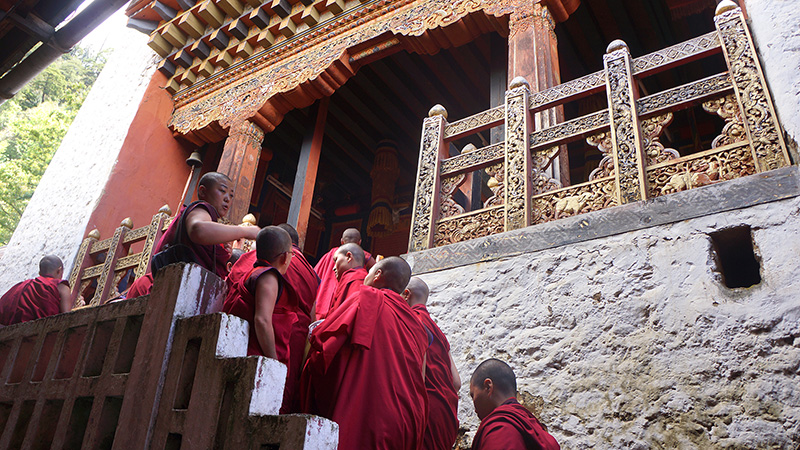 Tango Monastery
Tango Monastery
In conclusion, the religious sites of Bhutan captivate with their exquisite beauty and diverse array. From internationally acclaimed sites to hidden gems off the beaten path, each religious place offers its own unique allure. We invite you to explore and personalize your Bhutan itinerary, tailoring it to your interests and available time. Discover the enchantment of Bhutan's temples and create lasting memories in this remarkable land.

